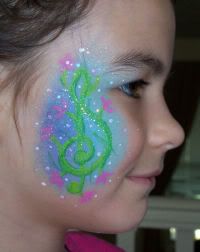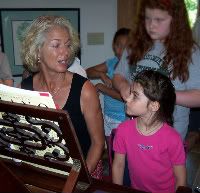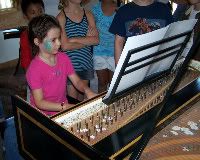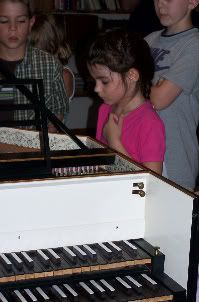The aim and final end of all music should be none other than the glory of God and the refreshment of the soul. ~Johann Sebastian Bach
 The Princess has been practicing an arrangement of Bach's Minuet in G for several weeks. It is one of my favorite pieces and I found it delightful to hear it played repeatedly, improving each passing day as she became more familiar with the music, but the crowning moment would be hearing her play it on a real harpsichord.
The Princess has been practicing an arrangement of Bach's Minuet in G for several weeks. It is one of my favorite pieces and I found it delightful to hear it played repeatedly, improving each passing day as she became more familiar with the music, but the crowning moment would be hearing her play it on a real harpsichord. Miss Trudy, the Princess' piano teacher, likes to have group classes a few times a year when all her students can learn and experience music in a different way. Two or three years ago, we visited Ann Schumann Earley's music studio in Canton, Georgia, to see her two harpsichords and she asked if anyone knew any Baroque pieces, which no one did at that time.
Miss Trudy, the Princess' piano teacher, likes to have group classes a few times a year when all her students can learn and experience music in a different way. Two or three years ago, we visited Ann Schumann Earley's music studio in Canton, Georgia, to see her two harpsichords and she asked if anyone knew any Baroque pieces, which no one did at that time. It was always a consideration to go back another time, but that did not come together until last Monday. This time, Miss Trudy would have some students with prepared pieces and my Princess was one of them.
It was always a consideration to go back another time, but that did not come together until last Monday. This time, Miss Trudy would have some students with prepared pieces and my Princess was one of them. This was very different from a recital. The climate controlled music room, housing two grand pianos and a harpsichord, was fashioned from a small apartment in a large, brick stable, although they no longer have horses. There were several children present ranging in ages and gathered around the instrument, which can be quite distracting, but the Princess kept her focus well.
 The harpsichord is basically a mechanized psaltery. The strings are plucked rather than stuck with a hammer as in the piano. The result is that no matter how much force is used to depress the keys, the volume is the same. The keys on the harpsichord also can differ from the piano in other ways other than weight. In this case, the keys that are normally white on the piano were black, and the black keys were white and thicker in width. It would be enough to throw off any child who had not practiced on it and has a limited hand span playing the Minuet in G.
The harpsichord is basically a mechanized psaltery. The strings are plucked rather than stuck with a hammer as in the piano. The result is that no matter how much force is used to depress the keys, the volume is the same. The keys on the harpsichord also can differ from the piano in other ways other than weight. In this case, the keys that are normally white on the piano were black, and the black keys were white and thicker in width. It would be enough to throw off any child who had not practiced on it and has a limited hand span playing the Minuet in G. The Princess did not play flawlessly, but only those who knew how the piece should have been played would have noticed just a minor mistake or two for she continued on as if she played it exactly as it was meant to be done. She is a natural at performing.
The Princess did not play flawlessly, but only those who knew how the piece should have been played would have noticed just a minor mistake or two for she continued on as if she played it exactly as it was meant to be done. She is a natural at performing. Afterward the other children were invited to play whatever pieces they knew at the time. I have to say that hearing "Boogie Woogie" on a harpsichord was quite interesting.
~ Even as this child was developing within my womb, I prayed that she would play the piano and, my Lord, You not only answered that prayer but blessed her with the ability to be gifted with music and to have the poise of a practiced performer. Thank you for her gifts. ~